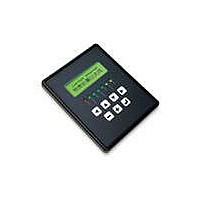20-101-0654 Rabbit Semiconductor, 20-101-0654 Datasheet - Page 45

20-101-0654
Manufacturer Part Number
20-101-0654
Description
INTERFACE OP6800 512K FLASH&SRAM
Manufacturer
Rabbit Semiconductor
Datasheet
1.101-0492.pdf
(110 pages)
Specifications of 20-101-0654
Module/board Type
Single Board Computer Module
Product
Modules
Processor Type
Rabbit 2000
Sram
128 KB
Flash
256 KB
Timers
8 bit, 10 bit
Backup Battery
Lithium Battery
Operating Voltage
9 V to 36 V
Power Consumption
1.5 W
Board Size
111 mm x 91 mm x 33 mm
Description/function
Computer Module
For Use With/related Products
OP6800
Lead Free Status / RoHS Status
Lead free / RoHS Compliant
Other names
20-101-654
20-101-654
20-101-654
5.2.3 Run the PINGME.C Demo
Connect a crossover cable from your computer’s Ethernet port to the OP6800’s RJ-45
Ethernet connector. Open this sample program from the
compile the program, and start it running under Dynamic C. When the program starts run-
ning, the green
is made. (Note: If the
you are using a hub perhaps the power is off on the hub or you are not using a straight-
through Ethernet cable.)
The next step is to ping the board from your PC. This can be done by bringing up the MS-
DOS window and running the ping program:
or by
and typing the command
Notice that the orange
indicates the transfer of data. The ping routine will ping the board four times and write a
summary message on the screen describing the operation.
5.2.4 Running More Demo Programs With a Direct Connection
The program
OP6800 a Web server. This program allows you to turn the LEDs on an attached Demon-
stration Board from the Tool Kit on and off from a remote Web browser. LED0 and LED1
on the OP6800 (LED1 and LED2 on the Demonstration Board) will match those on the
Web page. As long as you have not modified the
gram, enter the following server address in your Web browser to bring up the Web page
served by the sample program.
Otherwise use the TCP/IP settings you entered in the
library.
The sample program
cate with the OP6800 using the Telnet protocol. This program takes anything that comes
in on a port and sends it out Serial Port B. It uses digital input IN00 (which is connected to
Demonstration Board switch SW1) to indicate that the TCP/IP connection should be
closed and high-current output OUT01 to indicate that there is an active connection.You
may change the digital input and output to suit your application needs.
Follow the instructions included in the sample program. Run the Telnet program on your
PC (
CONFIG 1
wise use the TCP/IP settings you entered in the
you type will be printed in Dynamic C's
receiving the characters typed via TCP/IP.
User’s Manual
Start > Run telnet 10.10.6.100
http://10.10.6.100.
Start > Run
ping 10.10.6.100
ping 10.10.6.100
macro in the sample program, the IP address is 10.10.6.100 as shown; other-
SSI.C
LNK
light on the OP6800 should be on to indicate an Ethernet connection
TELNET.C
(
LNK
ACT
SAMPLES\OP6800\TCPIP\
light does not light, you may not have a crossover cable, or if
light flashes on the OP6800 while the ping is taking place, and
(
SAMPLES\OP6800\TCPIP\
STDIO
). As long as you have not modified the
TCP_CONFIG.LIB
window, indicating that the board is
TCPCONFIG 1
) demonstrates how to make the
LIB\TCPIP\TCP_CONFIG.LIB
SAMPLES\TCPIP\ICMP
) allows you to communi-
macro in the sample pro-
library. Each character
folder,
TCP-
41


















